
Click on the map for a Venezuela overview
|
Caribbean Landfalls Venezuela Pages Related Pages Venezuela Flora/Fauna |
Golfo de Cariaco
 Click on the map for a Venezuela overview |
Population: The Golf of Cariaco has the city of Cumana at tits western end,
but we didn't go there this trip. Otherwise there are a series of small villages and
towns along the southern shore. The population in this part of Venezuela show more of the
African heritage than elsewhere.
Landscape: Arid, cacti-covered hills to 500 feet on the north coast.
Scrub forest and hills to 1000 feet on the south. The road to the Guacharo
Caves goes over a 4,000 foot pass.
Visited: Along with
Jon's brother's family, November 16-22, 2002.
History: Laguna Grande lies on the southern cost of the Arraya Peninsula, home to small villages of fishermen, and in days of old, pirates on the western end of the peninsula. There are no paved roads on the peninsula, only jeep trails and foot paths.
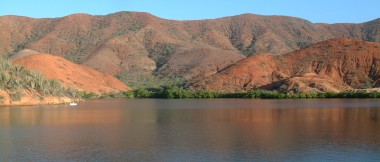 The beautiful green-fringed red hills of Laguna Grande |
(Sue) Returning to lovely Laguna Grande after 15 years felt like coming home. It was here, in 1987, that we spent more than 3 months with baby Christopher working on repairing some soft wood on Oriental Lady. It is as uninhabited as ever, so deliciously wild. The red-yellow and orange hills rise over 500 feet around a blue contorted series of inlets, each ringed with a necklace of brilliant green mangroves. The trees provide safe nesting for pelicans and frigate birds. The nightingale sings from the thorn trees and bay-winged hawks hunt from the tall snags. Underwater, though murky, I still found the huge scallops I remember from 1987, and we had seafood sauce for spaghetti made from a single large scallop one evening.
We stayed several nights here with Jon's brother, Tony, and his family with 3 kids windsurfing, dinghy sailing, and climbing the deserty hills. From the Lagoon we sailed east into the head of the Golfo of Cariaco to see the scarlet ibis in the mangroves. They are so bright red they are like Christmas ball decorations on a tree. The highlight of our visit to he Golfo of Cariaco was probably our excursion inland to the Cuevas do Guacharo (Oil Bird Caves). I had been in limestone caves before but never ones so inhabited by so many animals! There are over 20,000 oil birds living on the domed ceilings, crabs, spiders, millipedes, and two kinds of rats in the main caverns. Most amazingly we saw 2 ocelot-like cats that had made their home in the light-less part of the cave as well!!
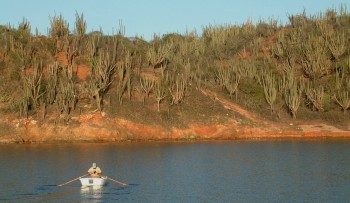 Tony rowing off to quietly watch the wildlife |
(Jon) Laguna Grande holds a special magic for us. Sue & I didn't realize how much we liked the desert until we spent some time in Namibia in 1980. Our 1 week excursion turned into a month. The moods and animals of the desert are delightful to behold, especially a desert with nice cool blue water and bright green mangroves to break up the reds, ochre, oranges, burnt sienna's, gold's, yellows & browns. Oh, and then there's the magnificent sunsets, coloring the whole western sky. Hiking through the thorn bushes was a challenge until we learned to walk up the dry washes until we could reach the foot of a ridge. The ridges themselves were bare enough that walking was easy, and the views spectacular.
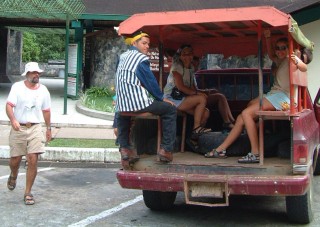 Too many hours in this gasping, wheezing truck |
Getting to the Guacharo Caves was a bit of an ethnic experience. Since
there were 9 of us, we needed a van. None were available, so we hired a
local "bus" as a taxi. This was a 12 year old Chevy pickup with
boards in the back to sit on and wooden cover if it rained. None of the
shock absorbers worked, at least 1 spring had been badly abused at some point,
and the engine didn't sound like it would last out the year. Even on level
terrain I could tell the driver was babying the engine, and we had a 4,000' pass
to go over! We limped up in first gear, everyone holding their breath.
The caves
themselves were amazing. The noise produced by the 500 or so birds that
were awake sounded like a monster lived in the cave. Very eerie.
Also loud enough that I couldn't hear much our guide said. I actually
preferred the second half of the cave, where we went through a narrow cut to an
area the birds couldn't get to. Then we could turn on our own headlights
and use the camera flash on the limestone formations (bright light causes the
birds to hit the cave walls and die).
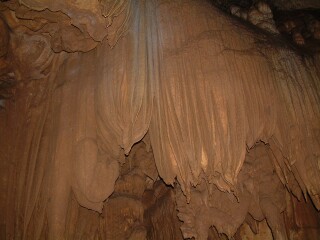 Limestone draperies sparkled in our lights |
 The limestone (flowstone) formations were fantastic |
(Amanda age 13) Now that's quite a presentation to follow. Laguna Grande was nice, although I don't think I would have had quite as much enthusiasm to see it if Tianna hadn't been there. We went out rowing in Nikka, checking out a sunken boat, going ashore to collect shells from a mud-flat. Once we beached the rowing dinghy on an island and went up to explore it. It was covered in cactus, and the wind was blowing really strongly, so it seemed as if a cactus would fall over any moment and impale us.
 Large scallop found in Laguna Grande |
It was the first
place we had been to in about a month or two that we could set up the sailing
dinghy and windsurfer, so we had a bit of fun doing that. I went out double in
Nikka for the first time sailing, so I could show Sean how to do it. We freaked
Mom out by going downwind behind an island so she couldn't see where we were
going. We were just fine, but they brought out Tomcat to see if we were okay. I
also tried the windsurfer again for the first time in a couple of months. I
couldn't believe how hard it seemed! The wind was hardly blowing, but I gave up
after about half an hour. Tony tried, too, but it was a lot harder for him to do
it, as a raw beginner, than me.
We tried
snorkeling there, and Mom brought up a huge lion's paw scallop - which turned out
to be quite tasty - but it got really mangrove-murky and most of the time I
couldn't see whether I was about to run into a big clump of fire coral or not.
Not fun.
 Looking down on Ocelot from high in the hills of Laguna Grande |
(Chris age 16) Laguna
Grande was beautiful, but the part of the trip that was the most interesting to
me was the Guacharo Caves. The cave is very long, though much of it is only
accessible by walking through a stream. The average visitor doe not get to see
more than a small portion of the caves, but even that is worth the trip.
Outside the cave, there is a
visitor's center with lots of fascinating information, including a cut-away
miniature of the cave that I found quite interesting. As we waited for our guide
to take us into the cave, I explored the outside area.
Our guide spoke no English, so my mom
was translating everything she said for the rest of us. As we approached the entrance
to the cave, we could hear the echoing squawks of the birds. As my dad said, it
sounded like some subterranean monster lived in the cave. As we walked through
the large opening to the cave, the light diminished and our eyes began to adjust
to the darkness. The first section of the cave has an amazingly high ceiling,
and oil birds can be seen (if you look very closely) all over it. The noise that
even a few of them can make is astonishing, in a large group they sound like
something out of a horror movie.
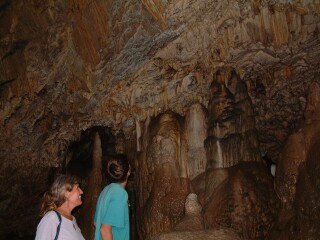 Sue & Chris examining limestone formations |
As we walked deeper into the shadowy recesses of the cave, our guide pointed out some of the things that make Guacharo caves unique. For one thing, there were plants all over the floor of the cave, excluding the path we walked on. Oil birds eat seeds, and the seeds pass through their digestive systems undamaged. Although the lack of light makes the plants small and pale, there is a stream running down the middle of the cave and foot-high shoots grew all around it. Second, the cave was full of animals. Aside from the birds, bats, and several species of spider, there were crickets 4 to 5 inches long and even longer millipedes, clinging to the rocks. Fish swam in the stream, and crabs with large claws scuttled along the banks. The most amazing animal was a wild cat, somewhat larger than the average housecat, which we saw and heard deeper in the caves. It turns out they are a kind of ocelot which have moved into the cave.
Top Level: Home | Destinations | Cruising Info | Underwater | Boat Guests | Ocelot | Sue | Jon | Amanda | Chris | Site Map | Make a Comment
|
If our information is useful, you can help by making a donation |
Copyright © 2000‑ Contact: Jon and Sue Hacking -- HackingFamily.com, svOcelot.com. All rights reserved.